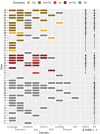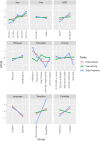Measurement bias in caregiver-report of early childhood behavior problems across demographic factors in an ECHO-wide diverse sample
- PMID: 38486952
- PMCID: PMC10933609
- DOI: 10.1002/jcv2.12198
Measurement bias in caregiver-report of early childhood behavior problems across demographic factors in an ECHO-wide diverse sample
Abstract
Background: Research and clinical practice rely heavily on caregiver-report measures, such as the Child Behavior Checklist 1.5-5 (CBCL/1.5-5), to gather information about early childhood behavior problems and to screen for child psychopathology. While studies have shown that demographic variables influence caregiver ratings of behavior problems, the extent to which the CBCL/1.5-5 functions equivalently at the item level across diverse samples is unknown.
Methods: Item-level data of CBCL/1.5-5 from a large sample of young children (N = 9087) were drawn from 26 cohorts in the Environmental influences on Child Health Outcomes program. Factor analyses and the alignment method were applied to examine measurement invariance (MI) and differential item functioning (DIF) across child (age, sex, bilingual status, and neurodevelopmental disorders), and caregiver (sex, education level, household income level, depression, and language version administered) characteristics. Child race was examined in sensitivity analyses.
Results: Items with the most impactful DIF across child and caregiver groupings were identified for Internalizing, Externalizing, and Total Problems. The robust item sets, excluding the high DIF items, showed good reliability and high correlation with the original Internalizing and Total Problems scales, with lower reliability for Externalizing. Language version of CBCL administration, education level and sex of the caregiver respondent showed the most significant impact on MI, followed by child age. Sensitivity analyses revealed that child race has a unique impact on DIF over and above socioeconomic status.
Conclusions: The CBCL/1.5-5, a caregiver-report measure of early childhood behavior problems, showed bias across demographic groups. Robust item sets with less DIF can measure Internalizing and Total Problems equally as well as the full item sets, with slightly lower reliability for Externalizing, and can be crosswalked to the metric of the full item set, enabling calculation of normed T scores based on more robust item sets.
Keywords: behavior problems; behavioral measures; pre‐school children; psychometrics.
© 2023 The Authors. JCPP Advances published by John Wiley & Sons Ltd on behalf of Association for Child and Adolescent Mental Health.
Conflict of interest statement
The authors have declared that they have no competing or potential conflicts of interest.
Figures





References
-
- Achenbach, T. M. , Ivanova, M. Y. , Rescorla, L. A. , Turner, L. V. , & Althoff, R. R. (2016). Internalizing/Externalizing problems: Review and recommendations for clinical and research applications. Journal of the American Academy of Child & Adolescent Psychiatry, 55(8), 647–656. 10.1016/j.jaac.2016.05.012 - DOI - PubMed
-
- Achenbach, T. M. , & Rescorla, L. A. (2001). Child behavior checklist 1.5 to 5. University of Vermont, Research Center for Children, Youth, & Families.
-
- Albano, A. D. (2016). equate: An R package for observed‐score linking and equating. Journal of Statistical Software, 74(8), 1–36. 10.18637/jss.v074.i08 - DOI
-
- Bayer, J. K. , Ukoumunne, O. C. , Mathers, M. , Wake, M. , Abdi, N. , & Hiscock, H. (2012). Development of children’s internalising and externalising problems from infancy to five years of age. Australian and New Zealand Journal of Psychiatry, 46(7), 659–668. SAGE Publications Ltd. 10.1177/0004867412450076 - DOI - PubMed
-
- Blackwell, C. K. , Tang, X. , Elliott, A. J. , Thomes, T. , Louwagie, H. , Gershon, R. , Schalet, B. D. , & Cella, D. (2021). (Vol. 33, pp. 610–618). American Psychological Association. 10.1037/pas0001009.Developing a common metric for depression across adulthood: Linking PROMIS depression with the Edinburgh Postnatal Depression Scale Psychological Assessment 7 - DOI - PMC - PubMed
Grants and funding
- U2C OD023375/OD/NIH HHS/United States
- UH3 OD023318/OD/NIH HHS/United States
- UH3 OD023271/OD/NIH HHS/United States
- UH3 OD023348/OD/NIH HHS/United States
- UH3 OD023248/OD/NIH HHS/United States
- UH3 OD023287/OD/NIH HHS/United States
- U24 OD023319/OD/NIH HHS/United States
- UH3 OD023305/OD/NIH HHS/United States
- UH3 OD023272/OD/NIH HHS/United States
- UH3 OD023347/OD/NIH HHS/United States
- UH3 OD023288/OD/NIH HHS/United States
- UH3 OD023320/OD/NIH HHS/United States
- UH3 OD023349/OD/NIH HHS/United States
- UH3 OD023337/OD/NIH HHS/United States
- U24 OD023382/OD/NIH HHS/United States
- UH3 OD023313/OD/NIH HHS/United States
- UH3 OD023289/OD/NIH HHS/United States
- UH3 OD023249/OD/NIH HHS/United States
- UH3 OD023389/OD/NIH HHS/United States
- UH3 OD023290/OD/NIH HHS/United States
- UH3 OD023285/OD/NIH HHS/United States
- UH3 OD023344/OD/NIH HHS/United States
- UH3 OD023251/OD/NIH HHS/United States
- UH3 OD023279/OD/NIH HHS/United States
- UG3 OD023279/OD/NIH HHS/United States
- UH3 OD023328/OD/NIH HHS/United States
